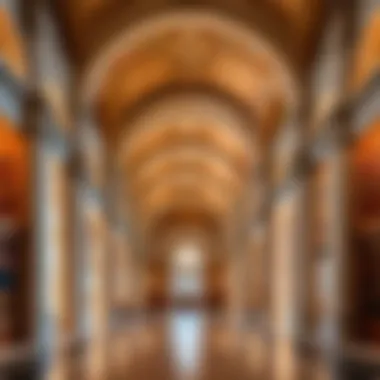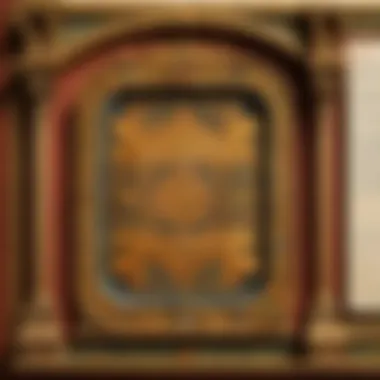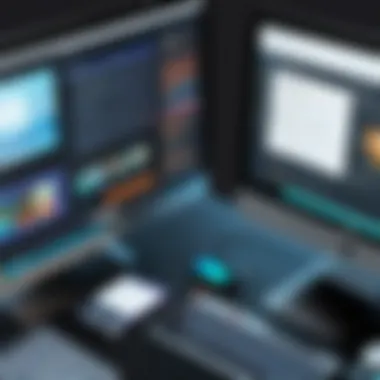Guided Exploration of the Library of Congress: A Virtual Tour


Intro
The Library of Congress stands as a monumental institution, encapsulating the vast history and cultural tapestry of the United States. It serves as a repository of knowledge, offering access to its collections digitally. With the restrictions of travel and the emergence of technology, the option for a virtual tour has allowed many to explore its depths from the comfort of their homes. This article will delve into the nuances of the Library's virtual offerings, emphasizing its rich resources, historical implications, and the tools that facilitate this experience.
Amid the explosion of digital content, the Library of Congress has successfully digitized a wealth of materials, enhancing its accessibility. The virtual tour is not just a window into a vast library; it’s a gateway to educational resources, cultural insights, and historical documents that have shaped a nation. The purpose of this article is to provide a comprehensive guide for navigating this digital treasure trove and to showcase the innovative approaches employed by the Library to connect with its users.
Online, learners and researchers can access historical texts, photographs, recordings, and much more. Each resource carries with it a story and significance that can elevate understanding and appreciation of various subjects. By tapping into these resources, users not only explore but also gain valuable insights to support their academic or personal pursuits.
Moreover, we will discuss the role of technology in enhancing the virtual experience, including the user interface, search functions, and educational tools provided by the Library. From first-time visitors to seasoned researchers, there are strategies and pathways explored throughout the Library's virtual space.
In the sections that follow, readers will discover how best to navigate the virtual offerings, understand the educational value provided, and learn about the digitization efforts that have made this possible. Whether you seek historical context or specific data, the Library can serve as a pivotal resource to meet your needs.
Prologue to the Library of Congress
The Library of Congress stands as a cornerstone of knowledge and culture in the United States. This institution is not only the largest library in the world but also a vital resource for scholars, professionals, and the general public. In the digital age, its significance continues to grow, as it adapts to meet the needs of a diverse audience through virtual exploration. Understanding the Library’s offerings is key for anyone interested in research, learning, and the preservation of historical knowledge.
Overview of the Institution
Established in 1800, the Library of Congress has evolved significantly over the centuries. Initially created to support the legislative needs of Congress, it now boasts a collection that includes millions of books, recordings, photographs, maps, and manuscripts. Each item reflects the rich tapestry of American history and culture, making the library a treasure trove for researchers and historians.
The Library is organized into several distinct divisions, each specializing in various fields of study. These divisions ensure that the vast array of materials is accessible and can be leveraged for scholarly and creative pursuits. Beyond its physical collections, the Library plays an important role in fostering the study of the humanities and social sciences, further influencing public policy and education.
Accessibility to such resources is critical in today’s society. The blend of historical preservation with modern technological initiatives helps bridge the gap between past and present. By providing a clear overview of what the library offers, we prepare users to navigate this extensive collection more efficiently.
Purpose of the Virtual Tour
The virtual tour of the Library of Congress serves multiple purposes. First and foremost, it offers a unique opportunity for people who may be unable to visit the library in person. This inclusive access reflects a commitment to democratizing knowledge and ensuring that everyone has the chance to explore its vast resources.
Moreover, the virtual tour highlights key aspects and functionalities of the institution. Users can interactively engage with digital collections that span centuries and cultures. This engagement not only increases awareness but also encourages further exploration and research.
By navigating through the various features available in the virtual platform, individuals can tailor their learning experience according to their interests and needs. The purpose of creating this virtual space goes beyond mere access; it aims to cultivate a deeper understanding of the Library's mission and encourage academic exploration.
"The importance of the Library of Congress extends into the digital realm, where knowledge is more accessible than ever before."
Historical Context of the Library
Understanding the historical context of the Library of Congress is key to appreciating its role and significance today. The Library is not only America’s premier library but also a window into its cultural and historical evolution. Established years ago, it reflects the changing needs of the American public and how information access has transformed over time. Exploring the founding and evolving collections provides insights into its mission to serve as a repository of knowledge and culture.
Founding of the Library
The Library of Congress was founded in 1800, primarily to serve the United States Congress. However, its role quickly grew beyond this initial mandate. It began with just a modest collection of books, mostly focused on the affairs of the government. The first major acquisition was Thomas Jefferson's personal library in 1815, which expanded the library's scope significantly. Jefferson envisioned the library as a place offering a wide range of knowledge, representing various disciplines and fields.
The Library’s mission is rooted in providing information to support the legislative process. Over the years, notable figures have contributed greatly to its development. Adam's and Madison's early influence laid a foundation for its expansion. The burning of the Capitol in 1814 posed a major setback, as the Library lost its books during the War of 1812. Indeed, this event catalyzed efforts to establish a more durable collection that could survive future threats, shaping its growth thereafter.
Evolving Collections
The collections of the Library of Congress have grown tremendously since its founding. Initially focused on government matters, the Library's collections now cover a myriad of subjects across various formats. From poems to legal documents, and foreign language resources, it reflects the diversity of American society. The Library has collected materials ranging from early American history to contemporary digital resources, incorporating items such as recordings, films, and photographs.
Another significant aspect is the emphasis on preservation. The Library actively engages in the digitization of its resources, allowing greater access to historical documents. This effort emphasizes the importance of making information available to a global audience. As the digital landscape continues to evolve, the Library strives to keep pace by expanding collections in new media types. Educators, researchers, and the general public benefit immensely from these resources, making the Library a crucial educational tool.
Navigating the Virtual Tour
Understanding how to navigate the virtual tour of the Library of Congress is crucial for maximizing the experience. As an expansive institution, the Library features a multitude of collections, resources, and historical elements waiting to be explored. Familiarizing yourself with the navigation process not only enhances your experience but also empowers you to engage more deeply with the materials available.
Accessing the Virtual Experience


To access the virtual tour, visit the official Library of Congress website. The platform offers an intuitive entry point where users can explore different sections. Various viewing options include guided tours, themed explorations, and self-directed browsing. It's important to have a stable internet connection, as high-resolution images and interactive features might require more bandwidth.
When first accessing the site, it's advisable to create a free account. Doing so allows you to save your preferences and bookmark specific items of interest. Users are encouraged to explore the timeline of the library, which outlines significant milestones in its history. From there, selecting specific exhibits leads to rich multimedia presentations that deepen understanding of the collections.
Interface Features
The interface of the virtual tour is designed for user-friendliness. Key features include:
- Search Functionality: A robust search bar enables users to look for specific items, collection types, or subjects.
- Virtual Exhibits: Highlighted sections showcase special exhibits, often including curated content that delve into specific themes or historical periods.
- Interactive Maps: Users can click through interactive maps, which provide geographical context to the collections displayed.
- Multimedia Elements: Many sections feature audio clips, videos, and images, which enhance the educational experience.
One notable aspect of the interface is its accessibility. The site is designed to accommodate users with varying levels of expertise, making it suitable for both novice and expert explorers. The responsiveness of the layout ensures that it functions well across different devices, whether you are on a desktop, tablet, or smartphone.
"The virtual tour serves as a bridge, connecting the historical riches of the Library of Congress to a global audience, allowing exploration from anywhere."
In summary, navigating the virtual tour is essential for reaching the full potential of what the Library of Congress has to offer. With a user-friendly interface and rich resources available online, scholars and curious minds alike can engage with history and culture in profound ways.
Key Collections Available
The Library of Congress is home to a vast array of key collections that hold immense value for researchers, educators, and anyone interested in cultural heritage. These collections reflect the historical and scholarly richness of the nation and offer unique resources that can enhance learning and research. The following sections will delve into specific collections, emphasizing their importance and utility in the virtual experience provided by the Library.
Digital Manuscripts
Digital manuscripts at the Library of Congress are essential for understanding the historical context of various events and figures. This collection comprises important documents that have been meticulously digitized, making them widely accessible. Scholars, teachers, and students benefit greatly from this resource, as it allows them to analyze primary sources without needing to visit the physical library.
The digitization process preserves the integrity of the manuscripts while also providing an opportunity for interactive learning. Users can zoom in on details, examine annotations, and engage with the material in an unprecedented manner. Categories within this collection might include famous letters, legislative records, and personal diaries.
Historical Maps
Historical maps in the Library’s collection represent significant geographical and cultural developments over time. These maps provide valuable insights into historical events, land use, and urban development. By exploring this collection, visitors can enhance their understanding of how geographical contexts influence historical narratives.
In the virtual space, users can access maps dating from the colonial period to contemporary times. This accessibility fosters a greater appreciation for cartography as a discipline and engages the audience in a way that is both educational and stimulating. The ability to view maps in high-resolution increases the detail and clarity, providing an avenue for comprehensive analysis.
Photographic Archives
The photographic archives at the Library of Congress serve as a visual testament to the American experience. This collection not only captures historical moments but also reflects societal changes through time. Photographs range from iconic images of pivotal events to everyday life, providing a broad spectrum of content for exploration.
In the context of a virtual tour, the photographic archives allow users to engage with history through visual storytelling. Each photograph offers a narrative, and the high-quality scans make it easier to examine fine details. Users can filter searches by themes, dates, or subjects, making the exploration process tailored to their interests.
"These collections offer the public an unparalleled opportunity to connect with the past in meaningful ways."
Educational Resources Offered
The Library of Congress provides a wide array of educational resources that significantly enhance the virtual tour experience. These resources cater to diverse audiences, including students, educators, researchers, and the general public. The importance of these resources lies in their capacity to promote learning, stimulate curiosity, and foster appreciation for historical and cultural materials.
Curated Learning Paths
Curated learning paths are essential educational frameworks that guide users through the vast collections and resources available in the Library of Congress. These paths are organized around specific themes or subjects, facilitating targeted exploration. For instance, a learning path might focus on American history, guiding users through documents, photographs, and maps that provide a detailed narrative of significant events.
Benefits of these curated paths include:
- Structured Learning: Users receive a clear direction, making it easier to navigate the extensive digital collections.
- Engagement: Themes are often selected to resonate with contemporary issues or historical significance, engaging users more effectively.
- Accessibility: Learning paths break down complex topics into manageable segments, thus enhancing understanding.
To further enhance these paths, the Library may incorporate multimedia elements such as videos and interactive content. This aim is not just to inform, but to inspire users to deepen their research and understanding of the subject matter.
Interactive Tools and Workshops
Interactive tools and workshops expand the educational offerings of the Library of Congress beyond mere access to resources. These tools allow users to interact with historical documents and artifacts in innovative ways. Workshops often come with guided instruction, making them suitable for various skill levels.


Some notable features of these offerings include:
- Virtual Workshops: These sessions might focus on skills like archival research or digital literacy, essential for current academic and professional environments.
- Interactive Simulations: Users can replicate the experience of an archivist or librarian, processing documents, learning cataloging techniques, or engaging in preservation practices.
- Collaboration Opportunities: These workshops often encourage collaborative learning, allowing users to engage with peers while working on projects, enhancing the overall learning atmosphere.
"The integration of interactive tools in education fosters a deeper understanding and retention of information."
Overall, the educational resources offered by the Library of Congress are vital components of the virtual tour experience. By providing structured learning paths and interactive opportunities, the Library enhances its role as a pivotal educational institution in the digital age.
Technological Innovations in Access
The evolution of technology has profoundly impacted how people access information, particularly in a vast institution like the Library of Congress. This section explores the significant advancements that enhance user engagement and information retrieval, two critical aspects for researchers, tech enthusiasts, and academic professionals.
Virtual Reality Integration
Virtual reality (VR) is transforming the landscape of how users experience cultural institutions. The Library of Congress embraces this by offering immersive experiences that allow users to engage directly with historical artifacts in a 3D environment. Users can walk through the majestic halls, interact with displays, and visualize the collections in ways that traditional browsing cannot achieve.
This innovative approach provides a sense of presence, making users feel as though they are physically in the library.
Some of the benefits include:
- Enhanced Engagement: Users are drawn into a narrative that a flat screen cannot convey. VR can turn a static display into a living story, capturing attention and encouraging deeper exploration.
- Accessibility: Individuals who cannot visit in person due to geographical or physical constraints can now experience the library as if they were there.
- Educational Opportunities: Educational institutions can use VR simulations for classroom learning, enhancing the curriculum with firsthand experiences that bring history to life.
However, integrating VR also presents challenges. Technology costs, equipment access, and ensuring content remains relevant and updated are all critical considerations that the Library must navigate.
Mobile Accessibility
In an age where smartphones lead in information consumption, mobile accessibility emerges as crucial for organizations aiming to reach a broader audience. The Library of Congress has developed a mobile-optimized platform that allows users to access various resources on the go, making it easier for individuals—especially students and researchers—to engage with the library’s extensive materials anytime and anywhere.
Key aspects of mobile accessibility include:
- User-friendly Interface: A simplified layout ensures that users can efficiently search for and view documents without the clutter that often accompanies desktop views. The transition from a computer screen to a smaller mobile interface has been crafted carefully to retain functionality while improving user experience.
- Responsive Design: The adaptability of web pages to various screen sizes guarantees that information is displayed clearly regardless of the device.
- Offline Access: Some features allow users to download materials for later viewing, which is especially beneficial for those in areas with limited internet connectivity.
"With mobile accessibility, the Library of Congress extends its reach, allowing modern users to engage with history right from their pockets."
Overall, the focus on technological innovations in access enables the Library of Congress to serve as a bridge, connecting vast collections of knowledge to an increasingly mobile and diverse audience.
Impact of the Library’s Digital Strategy
The Library of Congress has embraced a digital strategy that significantly alters how it engages with a wide range of audiences. This transformation is not just about putting materials online. It represents a comprehensive approach to make the vast resources of the library more accessible to everyone, including researchers, educators, and enthusiasts. The digital strategy is instrumental in redefining interactions with information and encourages a broader understanding of American history and culture.
Audience Engagement
Audience engagement is pivotal to the success of the Library's digital strategy. The Library employs various techniques to foster connections with users. These include interactive exhibitions, online lectures, and social media activities. Such engagements allow users to participate actively rather than merely consume content.
For instance, by hosting live-streamed events, the Library encourages real-time interaction among viewers. This not only enhances understanding but also allows audiences to engage with experts directly. The feedback and questions posed during these sessions can inform subsequent programs, creating a cycle of continuous improvement.
Furthermore, social media platforms have become a crucial vehicle for outreach. The Library of Congress has a strong presence on platforms like Facebook and Reddit, where users can explore collections and share their experiences. This approach broadens the audience and invites diverse participation, which enriches the collective understanding of the materials.
Global Reach
The digital strategy of the Library of Congress also dramatically expands its global reach. Previously, accessing its vast collections required physical presence in Washington, D.C. With the advent of online resources, people worldwide can now explore these collections from anywhere. This shift opens the door for international scholars and casual users alike to immerse themselves in American history and culture.
Moreover, the digitization efforts support multiple languages, which facilitates access for non-English speakers. By catering to a global audience, the Library enhances its relevance in an increasingly interconnected world.
In summary, the Library of Congress's digital strategy creates a vital platform for audience engagement and expands global access to its resources. As such, its initiatives not only preserve cultural heritage but also promote collective exploration and knowledge-sharing across borders.
Challenges Faced by the Library


The topic of challenges faced by the Library of Congress is critical to understanding the institution's operational dynamics. The library's ability to serve as a repository of knowledge is often hindered by various issues. Addressing these challenges is vital not only for the library itself but also for the users who rely on its resources. Two significant areas of concern are the preservation of digital artifacts and the management of funding and resources.
Preservation of Digital Artifacts
The preservation of digital artifacts poses notable challenges for the Library of Congress. As a leader in archiving a wealth of information, the library must ensure that the digital content it houses remains accessible and intact. Digital artifacts can include anything from e-books to audiovisual materials. This diversity creates complex preservation challenges, particularly as technological standards evolve rapidly.
Scholarly work and public interest hinge on the library’s ability to maintain its digital collections. If these artifacts become obsolete, the wealth of knowledge they contain could be lost forever. The staff must work diligently to implement strategic digital preservation practices. This includes regular format migrations and employing metadata standards to ensure metadata remains relevant as technology changes.
In addition, there are ethical considerations regarding copyright laws when archiving digital content. Institutions must navigate these laws while attempting to preserve material for public access. Maintaining a balance between accessibility and legal constraints is an ongoing challenge.
Funding and Resources
Funding and resource allocation represent another significant challenge for the Library of Congress. With the growing demand for digital content, adequate funding becomes increasingly critical. The library relies on government appropriations, which may not always meet the increasing technological needs.
Budget constraints can affect various operational aspects. For instance, if sufficient funds are not allocated for digital storage solutions, the library may struggle to accommodate its ever-expanding collections. Inadequate resources can also limit the library's ability to hire experts who are vital for curating and maintaining these collections.
Moreover, sustaining consistent funding is essential for implementing innovations. For a library of its stature, there may be expectation from the public to provide high-quality services and resources. Thus, continuous engagement with stakeholders to secure funding is imperative.
"Sustaining the Library of Congress's mission of preservation and accessibility relies heavily on sufficient funding and effective resource management."
In summary, both the preservation of digital artifacts and the management of funding and resources are pivotal challenges that could affect the Library of Congress's role as a primary custodian of knowledge. Recognizing these challenges can spark discussions around potential solutions and innovations that may advance the library's purpose and enhance its reach.
Future Directions for the Library
The Library of Congress stands at a significant crossroads, with technological advancements and increasing user expectations shaping its future. This section discusses essential elements of future directions for the Library, highlighting the benefits of expanding the digital landscape and fostering community collaboration. The aim is to ensure accessibility while preserving the rich knowledge and culture embedded within its collections.
Expansion of Digital Collections
The ongoing expansion of digital collections is a pivotal goal for the Library of Congress. In today’s digital age, vast quantities of information can be stored and shared online. This offers a unique chance for the Library to digitize more of its valuable materials, thus making them accessible to a broader audience. Digitizing historical documents, rare books, and audiovisual materials not only preserves these artifacts from physical degradation but also enhances their discoverability.
Benefits of this expansion include:
- Wider Accessibility: By increasing the volume of digitized content, more researchers and the general public can explore materials from anywhere in the world.
- Inclusive Representation: A varied selection of materials from diverse cultures and communities can create a more comprehensive archive.
- Enhanced Educational Opportunities: Educators can use these resources to design engaging curricula, benefiting students at all levels.
Moreover, integrating advanced metadata systems will optimize search functions, allowing users to find relevant materials quickly. This technological focus makes engaging with the library’s collections not just feasible but also efficient.
Increasing Community Collaboration
Another element that shapes the future of the Library is increasing community collaboration. Partnerships with educational institutions, local organizations, and tech companies can innovate the ways in which the Library serves its users. By drawing on the expertise and resources of these entities, the Library can create a dynamic approach to its community engagement.
Considerations include:
- Co-Creation of Content: Initiatives where community members contribute to digital collections can democratize knowledge and make the archive feel more relatable and connected.
- Workshops and Events: Collaborative workshops can stimulate interest in various topics, engaging different demographics while promoting literacy and learning.
- Feedback and Improvement: By actively seeking user feedback, the Library can refine its offerings based on direct input from its community, ensuring that it meets the needs of those it serves.
Engaging with the community not only enhances the Library’s collections but also strengthens its role as a crucial pillar of cultural preservation and education.
The future directions of the Library of Congress are crucial as they seek to balance tradition with modernity. By focusing efforts on expanding digital collections and fostering community collaboration, the Library can continue to be a vital resource for learners, researchers, and the public. This strategy not only preserves history but also prepares it for future generations.
Culmination
The conclusion of this article serves several crucial functions. It not only encapsulates the virtual tour of the Library of Congress but also reinforces the significance of that experience. Understanding the Library's offerings extends beyond historical artifacts; it invites users into an expanded realm of education and innovation.
Summarizing the Virtual Experience
This virtual experience integrates diverse collections, historical context, and educational resources seamlessly. The user-friendly interface enhances navigation while allowing for an engaging exploration of the Library's vast materials. Specific highlights include access to historic maps, digital manuscripts, and photographic archives, essential for researchers and learners alike. These resources shed light on American heritage, enabling a deeper comprehension of cultural narratives. By summarizing this experience, we aim to clarify how users can maximize the information and tools provided. The advantages are tangible: expanded knowledge, insight into unique collections, and a connection to the past.
Encouraging Continued Exploration
As users complete their initial virtual tour, continued exploration is paramount. The Library of Congress is not merely a static repository; it constantly evolves through new acquisitions and digital enhancements. We recommend returning periodically to discover newly added materials and updated tools. Engaging with interactive learning paths and workshops can amplify the educational benefits.
"The Library of Congress is the world’s largest library, with millions of books, recordings, photographs, maps, and manuscripts in its collections."
By grasping its importance, individuals can foster a lasting relationship with this institution. Embrace the Library's digital resources, and allow them to serve as continuous pathways for knowledge and inquiry.



